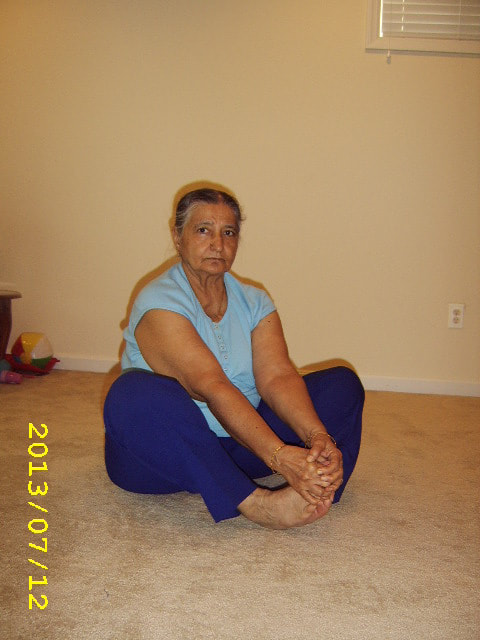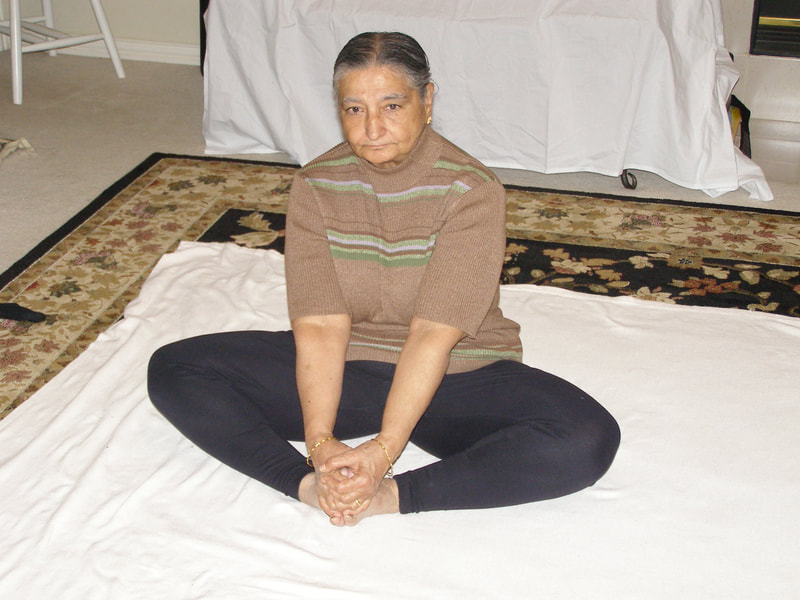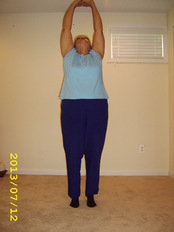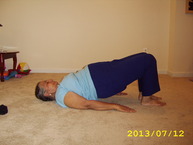Old age related knee & back problems
My experience and treatment of damaged Knees.
Muscle strengthening and physiotherapy sessions can help you reduce benign joint hyper-mobility.

Neck stretch
*Neck- Push up exercise:
This exercise besides stretching the neck is to strengthen the fingers, hands, wrists and upper arms, also effective for the legs and buttocks
Fish pose & Whale pose are derived from this exercise.
Neck- Push up exercise
1. Lie on the back with heels as far as possible with bended knees, hands beside both sides of the head.
2. Push down with your hands and feet. Raise your body a little (6”to8”) distance from the floor. Hold for a count of 1. 3. Arch your neck so that the top of the head rests on the floor.
4. Raise your body as far as possible. Hold for a count of 10. Lower your body slowly by lowering the back first and then the neck. Repeat.
5. Do these movements 3 times. Once when the body is only pushed up and twice when the neck is arched.
Benefits: 1. Hands can be used to push up by resting them on the ground, or this exercise can be performed by the fingertips to strengthen the fingers.
2. The first movement of raising the whole body a little is to ‘warm up’.
3. The full exercise is done by the neck arched up and head top touches the floor. Keep your knees together when lifting the body. This strengthens the legs and buttocks.
When you push hard with your hands or fingers, it will help strengthen your hands, wrists and upper arms.
4. Arching movements of the neck strengthen the neck.
Treated with Combined therapies
Even after being regular in my workouts, at the age of 76, I have reduced my knee pads and some points in the knee bones specially, in my left knee, resulting in my limping, unable to stand even for 5-10 minutes at a stretch, which restricted my movements even going out of the house for an hour or so, was a great problem. This was all due the overuse of the leg & knee muscles and joints. My knees were painful and it was as if some weight was on them, the legs were lifeless and heavy. I got my X-rays done and consulted an Orthopedic. He was surprised to see my report and told me how was I able to take even a step with such a damaged and inflamed knees. Though, he and my Physiotherapist were amazed by the flexibility of my body, which is the result of my 'Workout Plan’.
Treatment given for the damaged knees
(i) 10 physiotherapy sittings, after that I was suggested
(ii) To have hot bottle treatment for the knees, and
(iii) To take a gentle massage on the inflamed knees with muscular- relaxant ointment.
(iv). Basic stretching and strengthening leg exercises to strengthen my bones, groins and muscles were taught.
(v) For the pain, pain killer tablets were prescribed, which luckily I did not need due to my pranayama.
(vi). Advised to maintain my weight and to be careful about diet.
Physiotherapy Exercise:
1. Sit on the edge of a bed or on a chair, keep your back straight and with your knees on the edge of the chair or bed. Raise your right leg to the level of the bed or chair. Hold for few seconds. Slowly lower you’re your leg to the original position. Now do the complete exercise with your left foot. This completes the first exercise. Repeat the whole process 3 times.
2. Lie on your back straight with arms at your sides. Put a pillow or rolled towel under your knees. Gently and firmly push down your right knees into the pillow. Hold. Then release. Now push down your left knee on the pillow in the same way. Repeat 3 times.
3. Lying on your back place the pillow under your knees as before, slowly raise your right lower leg to the body level. Stretching the foot towards the body. Feel the stretch and release. Do the stretch with your left leg. Repeat 3 times.
4. Lying as above, place the pillow under your heels. Press the right heel on the pillow with your foot towards the body. Experience the stretch. Hold and release. Now do this stretch with your left leg to complete the exercise. Repeat 3 times.
5. Staying in the same position as above, bend your knees and join them. Put a pillow between your knees. Now press the pillow with your knees. You can feel the pressure. Hold for a few seconds and then release.
Repeat this stretch 3 times.
If you are up-to it, you can try the following exercise:
6. Lie on your back with legs straight in front. Raise your right leg and put it over the thigh of the left leg. Now raise your left leg straight as far as you conveniently can. Feel the pressure, hold and then lower the leg. Repeat the raising of the left leg 3 times. Slowly come to the original position with both legs straight.
Relax.
Now put your left leg over your right thigh and raise the right leg. Repeat the raising 3 times.
These exercises if done carefully and regularly can give relief to knee pain and assist you walk properly.
After Physiotherapy sittings I was at least, able to walk properly with less pain and uneasiness.
Besides this I continued by Workout plan with the doctor’s consult, eliminating those activities which strain or put pressure on the damaged knees (e.g. Sit in an asana, jumping, and vigorously jogging).
After two months of religiously following the prescribed treatment and exercises my legs are strong enough to keep me straight in my walk, and I can now stand for almost two hours at a stretch, with intermediate
After two months of religiously following the prescribed treatment and exercises my legs are strong enough to keep me straight in my walk, and I can now stand for almost two hours at a stretch, with intermediate sitting for 2 minutes, without any strain on my knees.
The inflammation has gone but the pain which has reduced much, is still there when I overexert my knees. I have to be careful while walking or sitting on the floor.
The exercises suggested by the Physiotherapist did wonders to my legs they have become so strong that I can now sit in an asana while doing Pranayama.
Precautions: My doctor advised me:
1. Not to climb up and down the stairs or walk on slops as it put much strain on the damaged knee joints.
2. Not to stand on one place more than 15 minutes, that too, to put one foot on the stool when I feel the strain in the knee.









